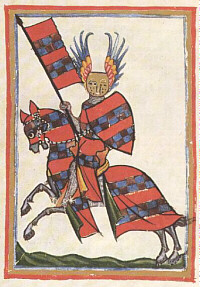
Manesse : "Die Manessesche Liederhandschrift", 1300-1315
 was graciously provided by the University of Heidelberg, Germany. The images are available for scientific and academic research purposes only and remain the property of the University of Heidelberg. To view the presentation of the Manesse plates from the University of Heidelberg, click on the image on the lower right or the university's coat of arms on the left. Any desire to publish this material elsewhere or for profit must be approved by the university. For more information, contact the university directly at Universitätsbibliothek Heidelberg.
was graciously provided by the University of Heidelberg, Germany. The images are available for scientific and academic research purposes only and remain the property of the University of Heidelberg. To view the presentation of the Manesse plates from the University of Heidelberg, click on the image on the lower right or the university's coat of arms on the left. Any desire to publish this material elsewhere or for profit must be approved by the university. For more information, contact the university directly at Universitätsbibliothek Heidelberg.
Recently, the Universitätsbibliothek Heidelberg has completed the entire Manesse manuscript containing more than 422 plates. The digital presentation of the plates appear to be digitally enhanced resulting in fantastic colour renderings of the plates. Click Cod. Pal. germ. 848 - Codex Manesse to view the online manuscript.
Backgrounder
Manessesche Liederhandschrift or the Manessesche song handwriting originated in in the first quarter 14th Century in the area of Zurich. It is spreading unit of a set of aristocrat and higher Klerus, who had put themselves the ambitious target to create as complete a collection of the minnesaenger and their poems as possible between 1160/70 and 1330. To this circle also the Mr. Manesse belonged, from whom the handwriting received its name. It is well-known also under " the name large Heidelberger " song handwriting.
Beside the poems of the minnesaenger also illustrations of the respective singer in job were given, which represents the artist in an environment characterizing him. In the following one these pictures are to be regarded more exactly detached by the Minnesang than source for mode, preparation technique and utensils.
The miniatures one-eat by four different painters and their assistants were painted. The major part (110 figures) was created by the so-called basic stick painter between approx. 1300 and 1315. These pictures are characterized by a special uniformity and by for the typical strong, absolute colours. Also the frameworks of the figures are uniformly in the colours zinnober and magenta, blue, green and gold held and wise mostly a touching or a lozenge examination up. The pictures of the basic stick painter represent mode and preparation technique, how them were usual since approx. 1230. Therefore these figures can be along-used also for this time as source well.
The supplement painters, who created the paintings to approx. 1330 still altogether created 27 miniatures, which are somewhat " more modern " regarding mode and armament. If the basic stick painter illustrated excluding chain shirts, then we here already find disk sections (e.g. board 73). Also otherwise the pictures of the supplement painters differ from those of the basic stick painter in color choice and framework examination: More more covered mixed colors were used, which lets the pictures altogether somewhat palely and which became frameworks with flowers, climbing or balls verziert work.
Overview
The manuscript is not presented in this library as a fechtbuch. However, it does provide some pictoral clues to life in the 14th century. Of interest are the plates that depict tournaments, which in some cases have a similar "look and feel" as the I.33 manuscript. For example, plate 63 does share similar attributes to I.33 with respect to the sword & buckler and the technique illustrated. Classic tournament harness is illustrated on plate 77 depicting Ulrich von Leichtenstein. Another illustration of a tournament found in plate 8 depicts the dukes of Anhalt in a melee with swords: one of the participants is wrestling with his opponent.
In order view an enlargement of that image, click here for details on registering with AEMMA and obtaining your Online Library electronic card or click on any image below to register for an online library e-Card.